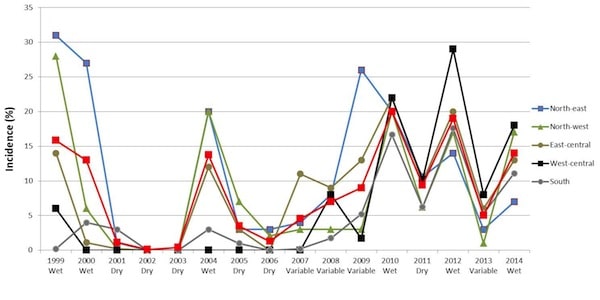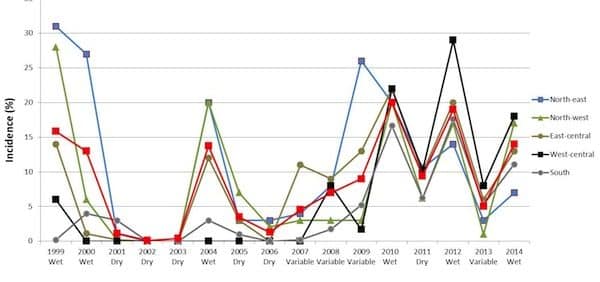Moisture is the key risk factor for sclerotinia stem rot. Without moisture before, during and after flowering, disease severity and the return on investment from fungicide will be lower than if moisture is present all through these periods. Moisture can come as rain, dew and/or humidity above 80%.

Infection can be high in hot weather as long as the moisture is there. High humidity and dew are often enough for sclerotinia fungus to produce the hyphae that release oxalic acid allowing the fungus to invade healthy plant tissue and infect the plant. Night and morning lows of 15°C are perfect, especially with heavy dew. Infection may not advance during the heat of the day, but it will grow at night.
Hot and dry conditions are not conducive to disease.
One big rain. If a region had been dry leading up to flowering, had one large rain, then turned dry again, this one big rain event will not increase the sclerotinia risk much. However if that one big rain is followed with high humidity, lots of dew (wet legs every morning you walk through the field) this may be enough to sustain the fungus. Note that if conditions stay wet after a few weeks of dry, it will take about two weeks before the release of spores from apothecia germinated by this rain will infect petals. If flowering is close to wrapping up within that time, a fungicide spray may not benefit the crop.
Any apothecia? Generally, soils need to be at field capacity for moisture for at least a week to initiate apothecia germination from sclerotia in the soil. As expected, most sclerotia depots have 0% germination due to low rainfall. There is 6-8% germination in Benito, Manitoba, but this level does not warrant fungicide treatment. See the sclerotia depot map. These depots are still at the experimental stage, so basing decisions on depot results alone is not a good idea. However, given the dry conditions, the results are not surprising.
Run the numbers. Yield potential is another key part of the sclerotinia risk assessment. Yield outlook of lower than 30 bu./ac. may not result in a return on fungicide investment, even if moisture conditions change in favour of the disease. Consider the cost of the fungicide as well as application cost, then consider the potential yield benefit when doing calculations. Click here for more on sclerotinia stem rot management, including risk assessment.

